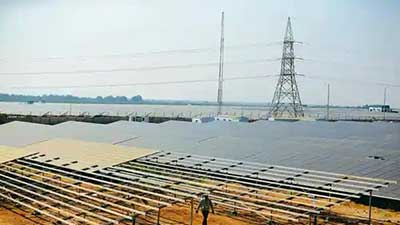Date: 19/12/2022
Relevance: GS-2: Indian Economy and issues relating to planning, mobilization, of resources, growth, development and employment; Infrastructure: Energy, Ports, Roads, Airports, and Railways etc.
Key Phrases: Interconnected Power Grid Across The South Asian Region, Emerge As A Unified Market, Energy Security And Affordability, Large-Scale Integration Of Renewable Energy, Effective Utilization Of Regional Resources
Why in News?
- India is working to create an interconnected power grid across the South Asian region covering as many countries as feasible.
- India today has a very robust power grid from north to south and east to west and in the future. It would be connected to neighboring countries including Myanmar, and Sri Lanka, and then expand that connection to Southeast Asian countries, to emerge as a unified market.
Key Highlights:
- The initiative demands sharing countries’ resources, investments, keeping the goals of energy security and affordability in mind.
- India is already working on that vision at a government-to-government level, as well as at a technocrat level to strengthen the grid interconnections between India and Nepal as well as India and Bhutan.
- There is a proposal on the same lines from India to Bangladesh, which has received encouraging and positive feedback.
NEED FOR AN INTERCONNECTED GRID:
- A large, interconnected grid across a subregion, region, or continent can bring far-away resources to the load center and exploit diversity of peak hours and time zones, among other factors.
- Such an interconnected grid facilitates large-scale integration of renewable energy with a larger balancing area and contributes to efforts to fulfill clean energy transition priorities.
- With looming climate change threats and the urgent need to tap renewable energy at scale, the role of electricity grid integration has resurfaced as a mechanism to contribute to climate change mitigation and facilitate large-scale decarbonization in a sustainable and economical manner.
CENTRALITY OF INDIA IN CROSS BORDER ELECTRICITY TRADE AND GRID INTEGRATION:
- India is centrally placed in South Asian region and with cross border interconnections with neighbouring countries, playing a major role in effective utilization of regional resources.
- Further, to facilitate import/ export of electricity between India and neighbouring countries, Ministry of Power, Govt. of India issued the "Guidelines for Import/Export (Cross Border) of Electricity-2018" on 18th December 2018.
- These Guidelines have allowed Cross Border Electricity Trade (CBET) through Indian power exchanges and trilateral CBET through tripartite agreements.
- Presently, India is connected with Nepal, Bhutan, Bangladesh and Myanmar
- As a first step, Bangladesh plans to import 500 MW of electricity from a hydropower project in Nepal through India.
- The 1,125 MW Dorjilung hydropower project in Bhutan is also envisioned to be a trilateral project with exports to Bangladesh via India.
- Currently, there is no physical interconnection between India and Sri Lanka and India and Pakistan due to various geographic, political, and economic factors.
BENEFITS OF INTEGRATING ELECTRICITY GRIDS IN SOUTH AND SOUTHEAST ASIA:
- South Asia is the least integrated region in Asia. It comprises Afghanistan, Bangladesh, Bhutan, India, Maldives, Nepal, Pakistan, and Sri Lanka and is home to nearly one-fourth of the world’s population.
- While South Asia used to be an electricity-starved region, governments have prioritized electricity sector expansion, and most of the countries (except Afghanistan) now have close to 100% electricity access.
- Bhutan and Nepal are almost 100% dependent on hydropower.
- Bangladesh relies on natural gas (57%), and dependence on coal is highest in India (55%).
- Pakistan relies on coal (27%) and oil (31%), whereas Maldives is almost entirely dependent on oil-based power generation.
- South Asia is blessed with abundant renewable energy resources. In terms of hydropower, it has around 350 GW of potential, of which only 18% is tapped. The region also has around 939 GW of solar power potential, of which only 3.8% is developed, and around 1,289 GW of wind power potential, of which only around 3% is developed.
Where Does India Stand On The Quantum Of Renewable Energy?
- Going by the current pace and trajectory, India is likely to meet about 62 percent of its energy requirements from non-fossil sources by 2030, exceeding the targeted 50 percent.
- As of now, 42 percent of its energy requirements is from non-fossil fuel sources.
- In the last 10 years, India has had interconnection with Bangladesh, strong connectivity with Nepal and import of power from Bhutan.
One Sun, One World, One Grid initiative by India:
- Under the ‘One Sun, One World, One Grid’ initiative, the Power Grid Corporation of India (PGCIL) has drawn up several plans.
- The vision is to finally have an interconnected grid with Gulf countries, and via Gulf countries to Africa and up north with Europe.
- Plans are also being drawn to connect grids from India to Myanmar, Myanmar to Thailand, Thailand to Singapore.
Conclusion:
- What India is doing today in terms of quantum of energy exchange with neighbouring countries can be doubled in the next three years
- For any market to develop, all the countries in the region have to be on the same footing—be it regulatory, market openness, cooperation between governments and cooperation between industry.
- A common platform needs to be created at a time when an attempt is being made to create a power exchange in the region.
Source: Hindu BL
Mains Question:
Q. Discuss the role the common power grid can play in climate change mitigation and facilitating large-scale decarbonization in a sustainable and economical manner.(150 words).






















